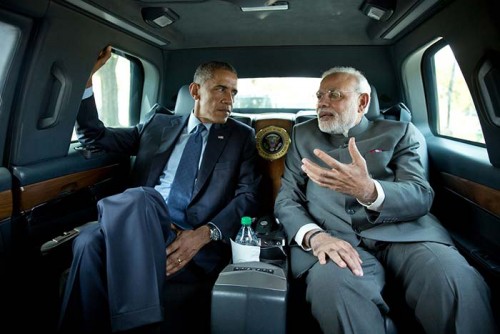
India’s relationship with the US is back on the rails with the US president Barack Obama and Prime Minister Narendra Modi taking its ownership, former Indian ambassador Meera Shankar has said and noted that the outcomes during Obama’s visit last month were marked by pragmatism as well as convergence.
Speaking at a panel discussion on `Indo-US relations after the Republic Day parade’ at the India Habitat Centre here, Shankar said that the visit had helped reset the bilateral relationship. “Overall it was extremely positive. It was high on both symbolism and substance,” Shankar noted.
Obama’s visit to India Jan 25-27 was marked by several firsts. He is the first US president to visit India twice while in office, the first to be chief guest at Republic Day parade and the first to do a joint radio broadcast with the Indian prime minister.
Shankar, who has been India’s ambassador to the US, said that the India-US nuclear deal changed the international regime for India but the bilateral relationship hit a plateau subsequently as the two governments focused on their domestic issues.
“The relationship is now back on the rails. (These are) leaders who are taking ownership focused on broader strategic aspect,” Shankar said at the discussion organised by the Indo-American Friendship Association.
Referring to the nuclear deal which was conceived in 2005 but could not be operationalised due to US concerns on India’s liability clauses, she said that there was effort by both sides to move ahead pragmatically. She said the two sides sidestepped some contentious economic issues, focused on larger business picture, worked for concrete action in renewable energy and decided to move beyond buyer-seller relationship in defence.
Referring to the US-India joint vision for the Asia Pacific and India Ocean region which referred to South China Sea, she said that the two countries had stated their convergence publicly which was a departure from the past.
Former foreign secetary Kapil Sibal said the there was “excellent personal chemistry between the two leaders” and it will be helpful in “getting White House focus on the relationship”.
On the nuclear deal, he said the two sides have removed it from the political plane and left it to companies to take it forward. However, he said India had, in effect, agreed “that will be no supplier liability (in case of a mishap)”.
Referring to the US-India joint vision, he said it has very important geopolitical implications and conveys a sense of how India can be strategically useful to the US.
In the joint vision, India and US had affirmed importance of safegaurding martitime security and ensuring freedom of navigation and over flight through out the region including South China Sea. The Chinese government had reacted sharply to the vision statement.
Sibal said Taliban was missing from the India-US joint statement despite the threat it posed to peace in the region.
George Sibly, minister in the US embassy, said that Obama’s visit has given “a tremendous upward boost” to the bilateral relationship and was “positive in both substance and symbolism”. He said the joint statement keeps track of the four months since Modi visited the US. On climate change, Sibly said he saw a gradual convergence between the two countries.
Congress MP Gaurav Gogoi said that US-India ties had already turned a new chapter during the previous UPA government. He, however, conceded that Modi had removed apprehensions about his ability to strike a chord with leaders on the international stage.
“We see a PM who is confident… imagery is important,” he said.
H.K Dua, MP and journalist, said there was an overdisplay of enthusiasm by Modi and he should not have publicly addressed the US president by his first name.